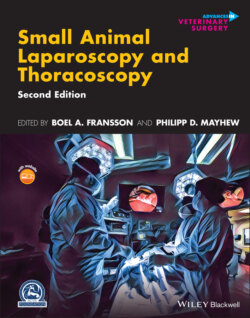Читать книгу Small Animal Laparoscopy and Thoracoscopy - Группа авторов - Страница 20
Controversy Galore: 1970s to 1990s
ОглавлениеFor twenty‐first century laparoscopic surgeons, the controversy surrounding laparoscopy as late as in the 1980s and 1990s seems unbelievable.
One of the remarkable pioneers, who persevered despite a massive storm of criticism, was the gynecologist Kurt Semm (1927–2003). In the 1970s, his innovations included the electronic insufflator with capability to precisely monitor intra‐abdominal pressures, which greatly increased pneumoperitoneum safety. He all but eliminated thermal injuries by improving on radio frequency cauterization. He pioneered extra‐ and intracorporeal knot tying and may have invented the loop applicator. However, the latter has been vehemently challenged by another gynecologist, H. Courtenay Clarke, who published on ligation and suturing techniques in the early 1970s.
In 1980, Semm performed the first laparoscopic appendectomy. No one could believe this was possible, and he was accused of pathological hoaxing. At the time, the gap between surgeons and gynecologists was immense. Semm's entrance into general surgery was seen as an attempt of a gynecologist to bolster his “operation ego” [4, 5]. All his attempts to publish on his surgical technique were refused with the reasoning that such “nonsense will never belong to general surgery” or that it was “unethical.” Even Semm's gynecological colleagues thought he had gone too far and attacked his publications, as being faulty and biased. The insulting criticism often went to extremes; the projector was unplugged during his presentations, with the motivation that unethical surgery was presented. After Semm lecturing on laparoscopic appendectomy, the President of the German Surgical Society wrote to the Board of Directors of the German Gynecological Society, suggesting suspension of Semm from medical practice.
Camran Nezhat (1947–), a laparoscopic surgeon affiliated with Stanford University medical center in, Palo Alto, CA, and with University of California San Francisco, is another such persevering pioneer [6]. He developed video‐laparoscopy, which removed the need for the surgeon to look directly through the eyepiece of the scope (Figure 2). This was a milestone and a prerequisite for the laparoscopic revolution that followed; a surgeon simply cannot perform advanced procedure crouched over an eye‐piece. His development also made him one of the most controversial figures in the movement of minimally invasive technology. Opponents of MIS accused laparoscopists like Nezhat to hide their complication rates and advancing dangerous methods for personal gain. A couple of high‐profiled lawsuits in the early 2000s triggered nationwide media coverage, as Nezhat was accused of medical malpractice and racketeering. Both suits were dismissed, and the allegations were considered frivolous lawsuits in the one case, and the attorney in the second was subsequently charged with contempt of court. Allegations of research fraud were made against Nezhat, all which were found unsubstantiated.
Figure 2 Laparoscopy performed in 1974, before the introduction of video laparoscopy.
Source:Courtesy of Dr. David C. Twedt.
Fortunately, some surgeons saw these hard‐earned achievements for their true value and by early 1990s laparoscopic appendectomies were performed by these early adaptors in vast numbers. Shortly thereafter the “laparoscopic revolution” broke out and suddenly Semm's and Nezhat's expertise and publications were in great demand. Finally, in 2002 Semm received the Pioneer in endoscopy award from the Board of Governors of the Society of American Gastrointestinal Endoscopic Surgeons (SAGES) [5]. Nezhat also has won numerous awards and honors from prestigious societies like ACOG, ACS, ASRM, and the Excel Award from the Society of Laparoendoscopic Surgeons.
